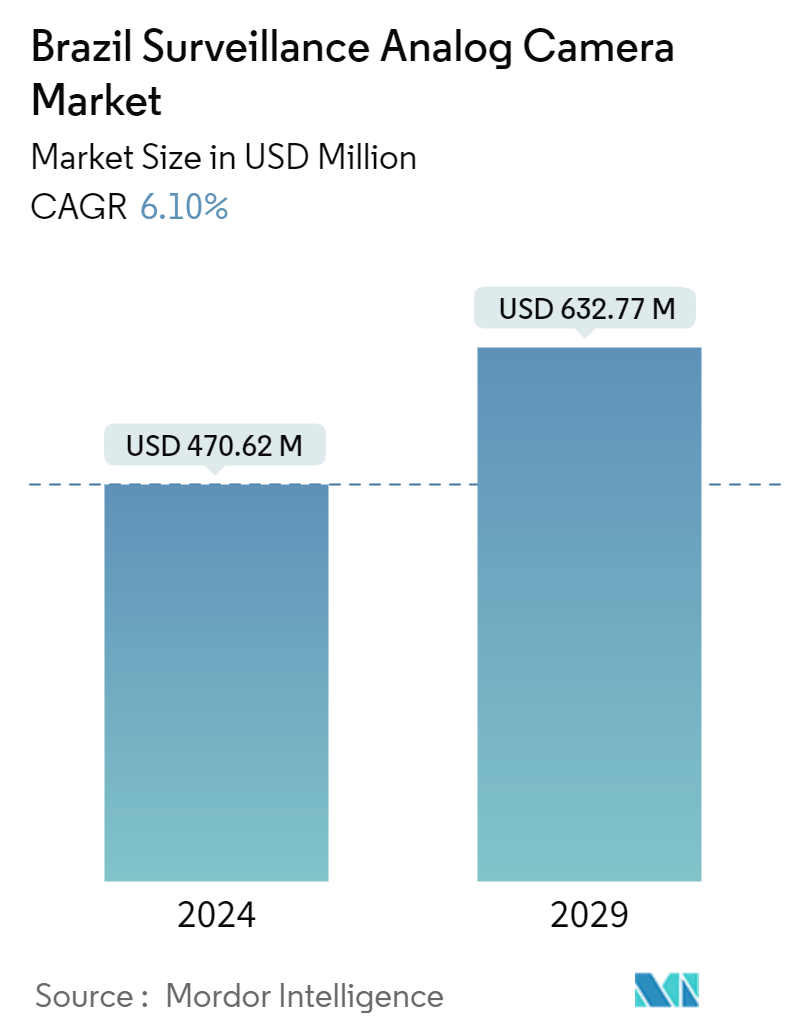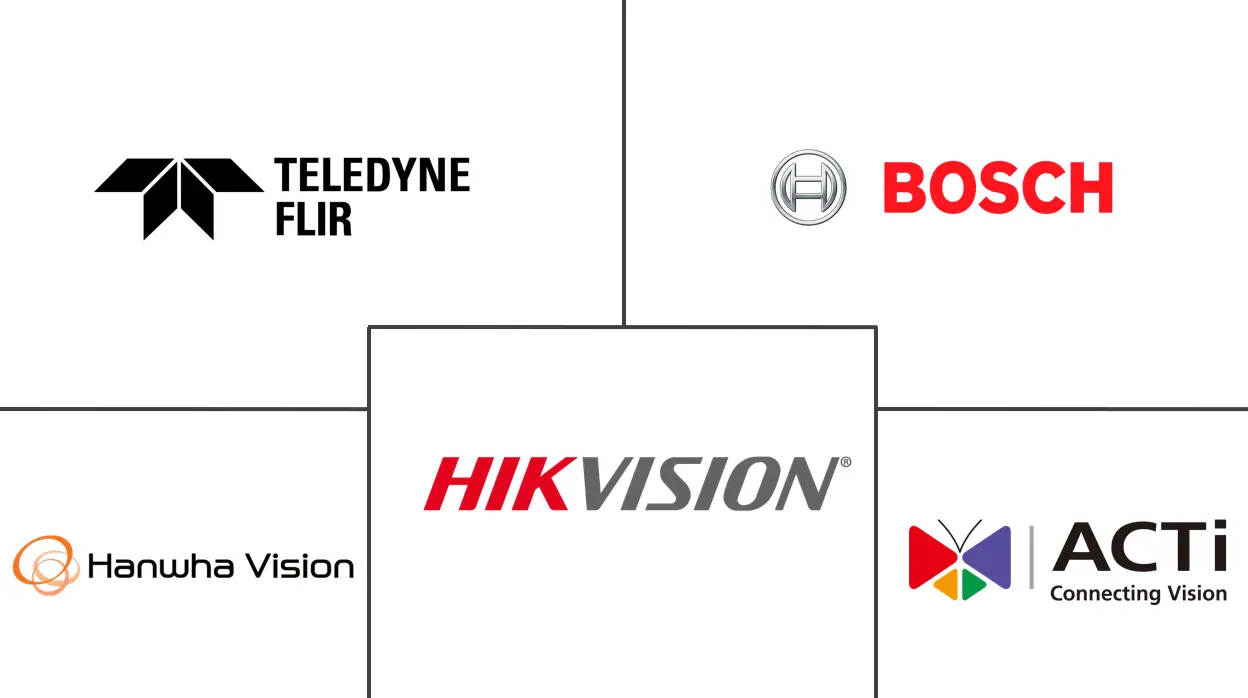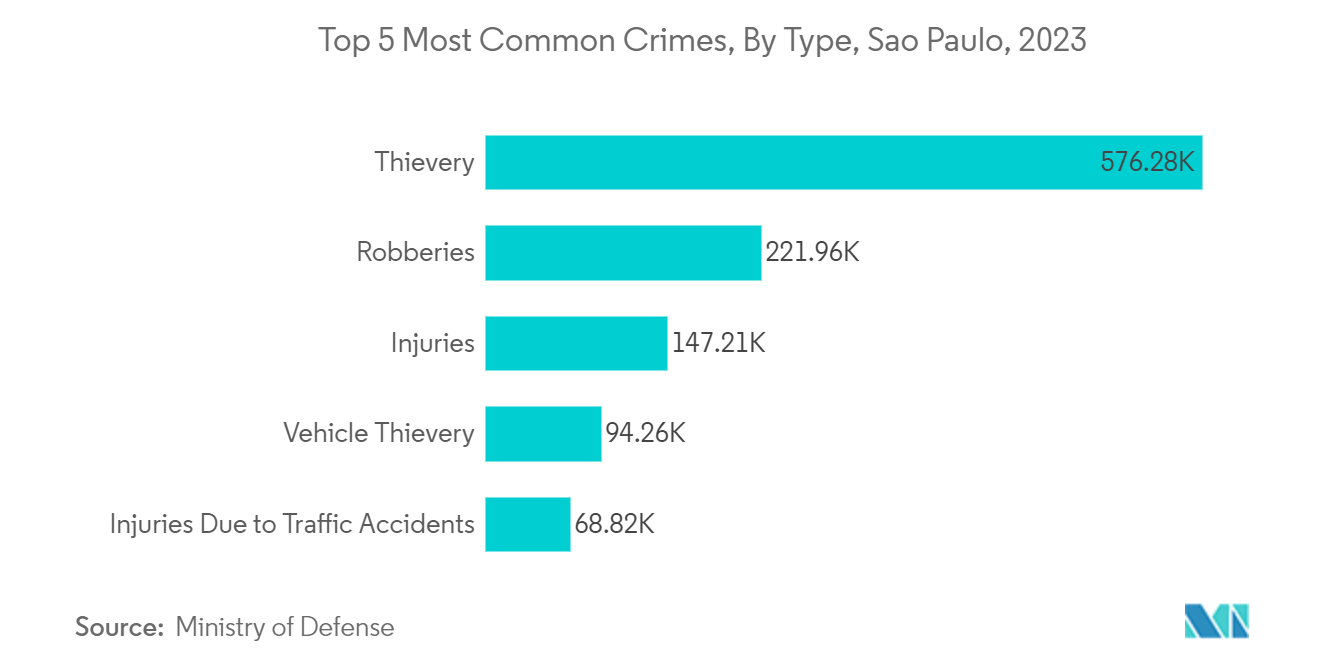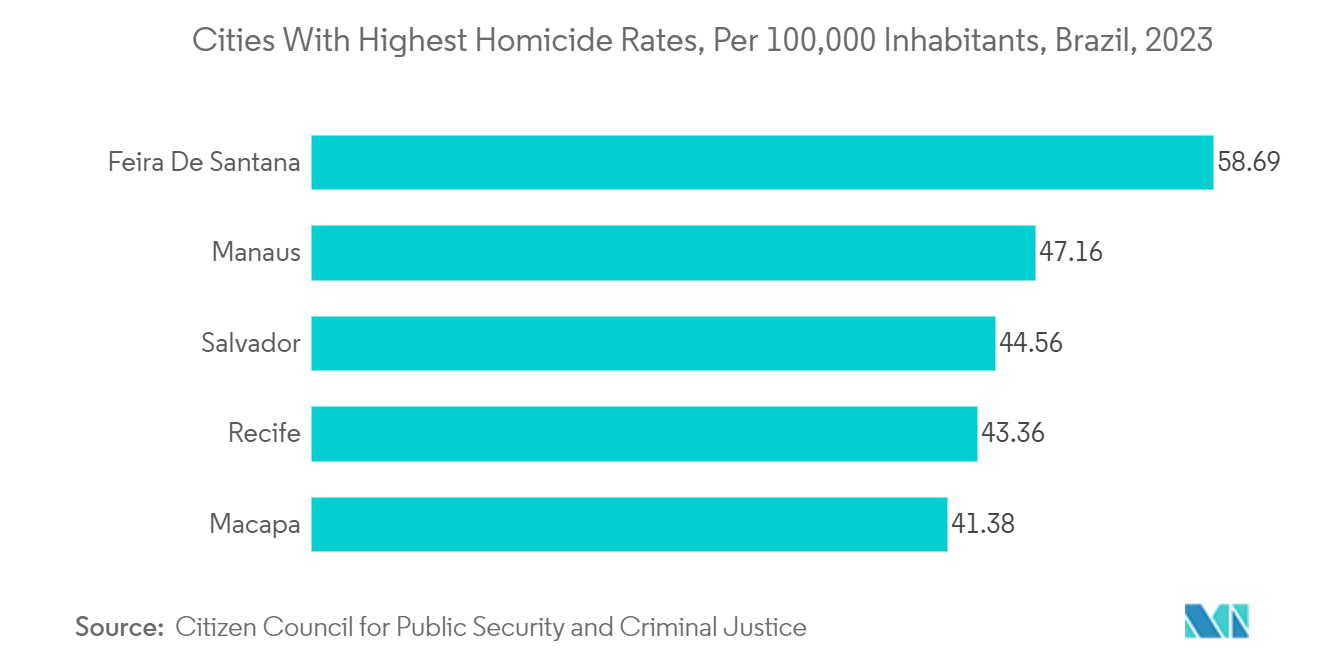Brazil Surveillance Analog Camera Market Size

| Study Period | 2019 - 2029 |
| Base Year For Estimation | 2023 |
| Market Size (2024) | USD 470.62 Million |
| Market Size (2029) | USD 632.77 Million |
| CAGR (2024 - 2029) | 6.10 % |
| Market Concentration | Low |
Major Players
*Disclaimer: Major Players sorted in no particular order |
Brazil Surveillance Analog Camera Market Analysis
The Brazil Surveillance Analog Camera Market size is estimated at USD 470.62 million in 2024, and is expected to reach USD 632.77 million by 2029, growing at a CAGR of 6.10% during the forecast period (2024-2029).
- Brazil is anticipated to remain among the prominent markets for analog surveillance cameras in the Latin American region. Several actors influence the market's growth in Brazil, including the favorable government outlook towards adopting surveillance cameras. In recent years, the Brazilian government has focused on enhancing public safety, especially in major urban hubs, and has rolled out initiatives like the National Public Security Plan. This plan involves a widespread deployment of surveillance cameras in cities like Rio de Janeiro and Sao Paulo, aiming to bolster public safety and curb crime.
- Smart city projects in Brazilian cities like Curitiba and Recife underscore technology integration in urban governance. Analog surveillance systems are pivotal in these endeavors due to their cost-effectiveness and reliability. Notably, the commercial sector increasingly favors analog cameras, recognizing their significance in loss prevention and safety measures.
- Small and medium-sized enterprises (SMEs), often constrained by limited budgets, find the affordability of analog cameras highly attractive. These businesses can set up robust surveillance systems without incurring the high costs typically associated with IP cameras. In cities like Sao Paulo, theft and robberies remain prevalent issues. With Brazil witnessing a surge in foreign direct investments, especially in manufacturing and industrial sectors, its FDI confidence index is on the rise, attracting billions in capital. This influx further bolsters the adoption of surveillance technologies, vital for safeguarding assets and operations.
- Brazil's robust economic growth has catalyzed substantial investments in infrastructure, spanning transportation, utilities, and urban projects. Surveillance systems are integral to these initiatives, ensuring both security and streamlined management. In 2023, the Brazilian government announced plans for a hefty USD 200 billion investment in infrastructure.
- Furthermore, as concerns over security heighten, homeowners and residential complexes in Brazil are increasingly turning to cost-effective security solutions. The simplicity of installing analog cameras not only saves on costs but also aligns well with community-driven safety initiatives, often operating on tight budgets. These cameras empower such groups to monitor their neighborhoods effectively and affordably.
- While analog cameras offer affordability and basic functionality, they do fall short in advanced features like high-end analytics, remote accessibility, and seamless integration with smart technologies. This limitation might pose challenges for users seeking sophisticated surveillance capabilities. As organizations pivot towards integrating cutting-edge technologies, analog systems may need to evolve to stay pertinent and ensure smooth interoperability with IP-based systems.
Brazil Surveillance Analog Camera Market Trends
Cost Effectiveness and Affordability of Analog Cameras Driving the Demand
- Many municipal governments in Brazil face stringent budgetary constraints, making investing in extensive surveillance systems challenging. Analog cameras, being more cost-effective than their IP counterparts, emerge as a pragmatic choice. Prioritizing cost-effectiveness, public safety initiatives opt for analog cameras, leveraging their lower initial outlay to achieve broader coverage in urban areas.
- Retail businesses grapple with ongoing challenges related to theft and loss prevention. Analog cameras, adept at monitoring store interiors, entry points, and checkout areas, emerge as a budget-friendly solution, aiding theft deterrence and loss management.
- Given their limited financial resources, SMEs find the affordability of analog cameras especially attractive. Opting for analog over IP cameras, these businesses can deploy comprehensive surveillance systems without incurring excessive costs. In cities like Sao Paulo, crimes such as theft and robbery are prevalent, with over 576,000 theft cases reported in 2023.
- As reported by Agencia Brazil, Brazil boasts over 29 million MSMEs and micro and small businesses alone, contributing to 71% of the 1.5 million new formal jobs created between January and September 2023. Thus, the demand for cost-effective security solutions is pronounced. Analog cameras, being scalable, cater well to the needs of these expanding businesses.
- Homeowners and residential complexes, increasingly aware of the need for property security, are turning to affordable solutions. The simple installation process of analog cameras cuts costs and aligns well with the budget constraints of community-driven safety initiatives. These cameras empower local groups to vigilantly and economically monitor their neighborhoods.

Government Sector to Remain a Significant Demand Driver
- The Brazilian government has rolled out a comprehensive national public security plan to bolster public safety and combat rising crime rates. A cornerstone of this strategy involves the widespread deployment of surveillance networks in urban areas. These networks serve a dual purpose: deterring criminal activities and bolstering the overall security landscape.
- Major cities like Sao Paulo, Rio de Janeiro, and Belo Horizonte have established surveillance networks as part of their urban security strategies. Additionally, cities such as Feira De Santana, Manaus, Salvador, Recife, Macapa, and many others have the highest homicide rates in the country. These networks rely heavily on analog cameras to provide continuous monitoring of streets, public squares, transportation hubs, and other critical areas.
- Recognizing the pivotal role of transportation in national development, the Brazilian government has substantially invested in upgrading its infrastructure. Under the government's Growth Acceleration Program (PAC), a staggering USD 200 billion has been earmarked for infrastructure, energy, and transportation projects over the next few years. Given these investments, surveillance cameras have become indispensable, especially in securing the country's public transport systems.
- Recent attacks on educational institutions have prompted the government to intensify its focus on school security and curb violence incitement. Schools and universities under government purview have turned to surveillance tools. These tools not only monitor campus activities but also serve as a deterrent against vandalism and unauthorized access, fostering a safer learning environment.
- Furthermore, as part of its 'smart city' endeavors, Brazil's municipalities are embracing cutting-edge technologies for urban management. Surveillance systems, particularly analog cameras, are at the forefront of these initiatives. They offer real-time data and monitoring capabilities, bolstering both management efficiency and public safety.

Brazil Surveillance Analog Camera Industry Overview
Brazil's Surveillance Analog Camera market is fragmented, with major international players competing by offering technologically advanced products. The market features a wide range of manufacturers offering various technologies and solutions. Chinese manufacturers are major contenders and provide tough competition. Many companies compete in the market, offering various surveillance camera types and integration services. Some key market players include Hikvision, Teledyne FLIR, Hanwha Vision, and BOSCH, among others.
- May 2024 - Bosch Security, a leading provider of surveillance camera solutions in Brazil, unveiled its latest offering: the 3100i fixed camera. This new addition, the FLEXIDOME 3100i, bolsters the existing 3100i product line, promising robust security features while maintaining a strong focus on video analytics and data protection. Boasting a non-intrusive design, the new dome camera is tailored for settings like office buildings, schools, and other areas where subtle surveillance is paramount.
Brazil Surveillance Analog Camera Market Leaders
-
Teledyne FLIR LLC
-
Hanwha Vision America
-
Hangzhou Hikvision Digital Technology Co., Ltd.
-
Bosch Sicherheitssysteme GmbH
-
ACTi Corporation
*Disclaimer: Major Players sorted in no particular order

Brazil Surveillance Analog Camera Market News
- April 2024 - Hikvision unveiled the newest iteration of its Turbo HD line, Turbo HD 8.0, which enhances analog security offerings. Noteworthy is the debut of a dual-lens camera, leveraging proprietary image-stitching tech to produce seamless 180-degree visuals. Thanks to its sizeable F1.0 aperture and high-sensitivity sensors, these images boast vivid colors even in low-light conditions. Moreover, the camera's updated design prioritizes compactness, enhancing its discretion and visual appeal, especially for small to medium enterprises.
- October 2023: Hikvision introduced the ColorVu Fixed Turret (DS-2CE70DF0T-MF) and Bullet (DS-2CE10DF0T-F) Cameras, pioneering the F1.0 aperture in their class. These 2 MP analog cameras offer round-the-clock, high-quality, full-color imaging, support HD over analog cabling for easy upgrades, and feature 3D Digital Noise Reduction (DNR) technology. According to the company, the F1.0 aperture on the ColorVu Cameras ensures vivid colors even in low-light settings.
Brazil Surveillance Analog Camera Market Report - Table of Contents
1. INTRODUCTION
- 1.1 Study Assumptions and Market Definition
- 1.2 Scope of the Study
2. RESEARCH METHODOLOGY
3. EXECUTIVE SUMMARY
4. MARKET INSIGHTS
- 4.1 Market Overview
-
4.2 Industry Attractiveness - Porter's Five Forces Analysis
- 4.2.1 Bargaining Power of Suppliers
- 4.2.2 Bargaining Power of Consumers
- 4.2.3 Threat of New Entrants
- 4.2.4 Threat of Substitutes
- 4.2.5 Intensity of Competitive Rivalry
- 4.3 An Assessment of Impact of Macroeconomic Trends on The Market
5. MARKET DYNAMICS
-
5.1 Market Drivers
- 5.1.1 Cost Effectiveness and Affordability
- 5.1.2 Growing Adoption of Surveillance Camera For Crime Prevention
-
5.2 Market Restraints
- 5.2.1 Technological Limitation
6. MARKET SEGMENTATION
-
6.1 By End-User Industry
- 6.1.1 Government
- 6.1.2 Banking
- 6.1.3 Healthcare
- 6.1.4 Transportation & Logistics
- 6.1.5 Industrial
- 6.1.6 Others
7. COMPETITIVE LANDSCAPE
-
7.1 Company Profiles*
- 7.1.1 Teledyne FLIR LLC
- 7.1.2 Hangzhou Hikvision Digital Technology Co., Ltd.
- 7.1.3 Hanwha Vision America
- 7.1.4 ACTi Corporation
- 7.1.5 Bosch Sicherheitssysteme GmbH
- 7.1.6 Pelco (Motorola Solutions)
- 7.1.7 Zhejiang Uniview Technologies Co.,Ltd.
- 7.1.8 IDIS Ltd.
- 7.1.9 Honeywell International Inc.
- 7.1.10 Panasonic Corporation
- 7.1.11 CP Plus
8. INVESTMENT ANALYSIS
9. FUTURE OF THE MARKET
** Subject To AvailablityBrazil Surveillance Analog Camera Industry Segmentation
A surveillance analog camera is a security device that captures video footage in an analog format, typically transmitting signals over coaxial cables to a recording device or monitor. While they offer cost-effective solutions for basic security needs, analog cameras generally provide lower resolution than digital or IP cameras and have limited integration capabilities with advanced surveillance technologies.
The study tracks the revenue accrued through the sale of surveillance analog camera products by various players operating in Brazil as the baseline for market estimations. The study also tracks the key market parameters, underlying growth influencers, and major vendors operating in the industry, which supports the market estimations and growth rates over the forecast period. The study further analyses the overall impact of macroeconomic factors on the market. The report’s scope encompasses market sizing and forecasts for the various market segments.
Brazil's surveillance analog camera market is segmented by end-user industry (government, banking, healthcare, transportation & logistics, industrial, and others). The market sizes and forecasts are provided in terms of value (USD) for all the above segments.
| By End-User Industry | Government |
| Banking | |
| Healthcare | |
| Transportation & Logistics | |
| Industrial | |
| Others |
Brazil Surveillance Analog Camera Market Research FAQs
How big is the Brazil Surveillance Analog Camera Market?
The Brazil Surveillance Analog Camera Market size is expected to reach USD 470.62 million in 2024 and grow at a CAGR of 6.10% to reach USD 632.77 million by 2029.
What is the current Brazil Surveillance Analog Camera Market size?
In 2024, the Brazil Surveillance Analog Camera Market size is expected to reach USD 470.62 million.
Who are the key players in Brazil Surveillance Analog Camera Market?
Teledyne FLIR LLC, Hanwha Vision America, Hangzhou Hikvision Digital Technology Co., Ltd., Bosch Sicherheitssysteme GmbH and ACTi Corporation are the major companies operating in the Brazil Surveillance Analog Camera Market.
What years does this Brazil Surveillance Analog Camera Market cover, and what was the market size in 2023?
In 2023, the Brazil Surveillance Analog Camera Market size was estimated at USD 441.91 million. The report covers the Brazil Surveillance Analog Camera Market historical market size for years: 2019, 2020, 2021, 2022 and 2023. The report also forecasts the Brazil Surveillance Analog Camera Market size for years: 2024, 2025, 2026, 2027, 2028 and 2029.
Brazil Surveillance Analog Camera Industry Report
Statistics for the 2024 Brazil Surveillance Analog Camera market share, size and revenue growth rate, created by Mordor Intelligence™ Industry Reports. Brazil Surveillance Analog Camera analysis includes a market forecast outlook for 2024 to 2029 and historical overview. Get a sample of this industry analysis as a free report PDF download.



